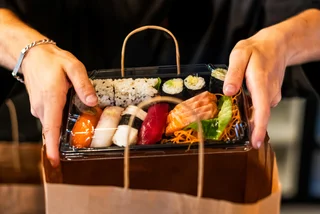
During the Royal Wedding media blitz, I read a magazine profile of Kate Middleton which reported that, “She eats pâté.” It was unclear to me exactly what the author was trying to say about the future duchess. That she’s not as down-to-earth as everybody thinks she is? Or maybe he meant just the opposite: Will’s wife’s affinity for spreadable meat makes her accessible. Herein lies the problem with classifying pâté—I’m forever undecided if it’s a luxury delicacy or rustic snack. We never had pâté growing up. Much to my teenage disgust, my parents occasionally bought liverwurst and braunschweiger from the supermarket deli; later in life I sampled and enjoyed silky pâté at an upscale party or two. Then I moved to Prague and while orienting myself to the grocery stores, i.e. spending hours circling Delvita in a food-induced fugue, I discovered that pâté is a national obsession.

PARTNER ARTICLE
Like so many goods that are shopping-cart items in Europe (long, flat chocolate bars, fresh bread, rounds of soft cheese) but considered splurges in America, pâté, or paštika, is a staple of the Czech grocery list. While the classic French version—long synonymous with fine dining—adds cream or butter and cognac to the basic recipe of chicken liver and fat, and is baked en croûte, Czech paštika gets by on pork liver (játra) and lard (vepřové sádlo). The ingredients in paštika vary by region and family, but the cooking method typically remains the same: boil and mash livers, season, refrigerate, serve. Historical mentions of eel, cod, crayfish, and pigeon paštika at medieval Czech feasts suggest that it was once, in fact, a dish fit for royalty, though more recent history locates paštika in rural kitchens where for centuries it has been made as part of the zabijačka, or annual pig slaughtering, festivities. Domácí Kuchařka, the bible of classic Czech cuisine written by Magdalena Rettigová in 1826, devotes an entire fifteen pages to the dish, including recipes for paštika with Parmesan cheese and a Beef Wellington-style pastry dish with a paštika center.

Paštika in the Czech Republic is generally a “for-the-people” kind of treat. Head to the paštika aisle, just opposite the canned tuna, in any shop and check out the little universe of preserved meat-liver spreads. From tinfoil cups large enough to hold a dab to squat glass jars embellished with decorative fabric and twine, the choice of packaging and flavors is overwhelming. There’s Moravian paštika with wine, paštika revved up with red and black pepper especially for spreading on garlic-toast (topinky), and turkey paštika with egg. Hamé Májka in the yellow container ranks alongside Kofola and Sojový Suk as nostalgic symbol of the Communist past. You’ll also notice a variety of paštika with peas called “Favorit i na cesty”, bearing a photo of a mini-van on the lid, which leads us to this: Their tendency to travel with spreadable meat has earned Czech tourists the nickname “paštikáři”. You know you’re a Czech tourist if you’ve packed equal amounts of sunscreen and paštika.

The supermarket paštika selection isn’t limited to the portable variety. As the country warms up to specialty food shops and gourmet flavors, a number of companies are offering premium lines in the vein of French-style pâté. For more discerning palettes, aspic-topped slices of pâté and terrines of foie gras can be found in the refrigerator section with the charcuterie. One of the more recognizable names in pâté production, Pâté du Chef—their line of terrines is adorned with pencil drawings of the woodland creature you’re about to spread on your cracker—has recently opened a shop, Pâté du Chef Delicatessen that specializes in the uppity French version, as well as the humble paštika in its myriad forms.

Take home a 2-kilo pâté en croûte, topped with fanned fruit slices and baked into a pear-shaped ceramic dish (wine-bottle and apple-shaped crocks are available, too) or ask for a slice or sample of the baked pâtés and tunnels from the display cases. Choose from a mix of goose, duck, salmon, and game (venison, boar) pâtés flavored with cranberries, plum and bacon, port wine, champagne, and hazelnuts. We tried the Brussels pâté, chicken liver with cranberries, which recently won a reader’s-choice award from Apetit magazine.

It was incredibly creamy and smooth with a deep, rich flavor bolstered by bacon, and none of the chalky after taste that normally puts us off the store-bought kind. The Ardennes pâté was bristling with green peppercorns and thyme and tasted of smoky pork belly. The vegetarian pâté wasn’t available for sampling that day, but we were told it can be ordered upon request. Bizarre but not totally unsuccessful was a Brussels pâté with papaya. Prices range from 30-50 CZK/100g. You can also buy a 220-gram “pâté cake” that looks like a leathery birthday cake but smells like liver, for 990 CZK.

Aside from immaculately prepared pâtés, pick-up pre-packaged items such as a the beloved Czech paštika spread, a “light and bio” pâté, logs of pâté, a variety of foie gras terrines, and seasonal pâtés that come with a serving knife. A few of our favorites slices were the Provencal pâté which is packed with lots of minced onion and herbs and had a nice brothy aroma. I’m always a fan of crisp green apple in any savory combination and the green apple pâté slice didn’t disappoint. The beer pâté probably tastes best when paired with beer, on its own it was the least exciting of the lot. At 29 CZK, the 125-gram slices were a good value and though you can purchase some of them at the supermarket, the selection, and atmosphere, is much better in the shop.

As to the question of what to serve with your pâté, Pâté du Chef stocks gourmet crackers, marmalades, and mustards, as well as a wide range of imported beer and wine. It’s also a full-service delicatessen. From the deli offerings, I highly recommend the wasabi cheese, which delivers a nice sinus-searing jolt and the roast beef, perfectly pink on the inside with a peppery crust. Lest you worry that you’ve somehow been transported to the countryside of Wallonia, the surly Czech service will remind you exactly where you are.
Pâté du Chef Delicatessen
Myslíkova 32 (entrance on Spálená 1)120 00 Praha 2
Monday-Friday 8:00-19:00
Saturday 9:00-17:00
Sunday closed
Photos courtesy of www.pastikovyobchod.cz
View Other For Foodies locations in a larger map












 Reading time: 5 minutes
Reading time: 5 minutes 

















